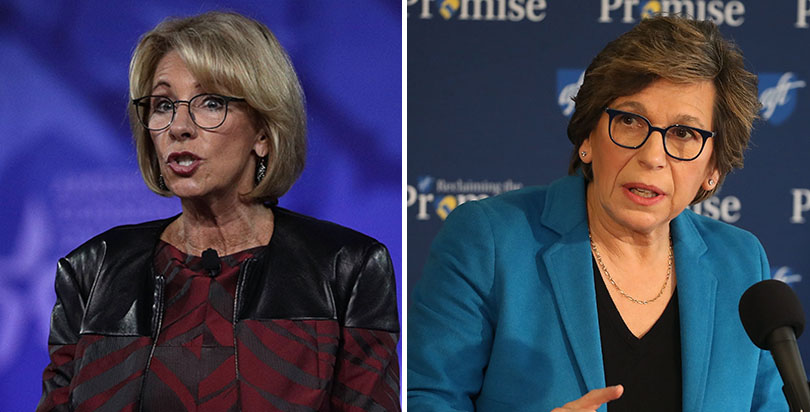Whitmire: Is DeVos Still Planning a School Tour With Weingarten? Here’s the First Place They Should Go

A version of this column originally appeared at The Hill
Dear Secretary:
I saw photos from your Monday visit to the Kimberly Hampton Primary School at the Fort Bragg Army post in North Carolina and was reminded of the deal you made a month ago with AFT President Randi Weingarten: She’d guide you through one public school she admires, and in return you’d guide her through a “choice” school you admire.
Excellent! This could prove to be an important excursion for each of you, perhaps leading to an easing of tensions that spiked during the confirmation process.
April is "Month of Military Child",
Education Secretary DeVos celebrates with Ft. Bragg 5 & 6 year olds @WNCN pic.twitter.com/LLzJv14NmA— Nate Rodgers (@NateWants2Know) April 3, 2017
Randi will have no trouble finding a great traditional public school to tour. A good place to start would be the 2016 National Blue Ribbon School winners, which have included both traditional public schools and charter schools.
But what about some great “choice” schools to spotlight for the national media?
I would stick to charter schools (especially since the results from voucher programs look a bit iffy). In the nation’s urban areas, charter schools offer the most promising school reform this nation has ever seen.
As someone who just published a book on the nation’s top charter schools, I have some suggestions about schools to visit. And my list is unique: These are schools where you may have as much to learn as Randi.
Let’s start in Boston at one of Brooke Charter Schools’ K-8 campuses. These are populated almost entirely by low-income African-American and Hispanic students, and yet, looking at their academic results, you might assume their students come from wealthy suburbs.
How do they do it? Superb teacher quality and rich curriculum. Before you go, watch the video:

The lesson learned here for any union leader: Yes, fighting poverty should remain a top priority, but schools alone can make life-changing differences.
For you, the lesson learned is that schools such as Brooke don’t emerge as a result of free market forces. If you want the federal government to play a role in growing more choice schools like Brooke, dig into Brooke’s history.
Next on the tour is Newark, home to the North Star Academy Alexander Street school, a school that once was so depressing that former Newark chancellor Cami Anderson used to cry after she visited. Then, Uncommon Schools took over the entire school — the building and all its students — and within one year, academic outcomes soared.
The second-year scores are even better, with the low-income Alexander students beating both the math and reading state averages for middle-class kids. (Read my take on those impressive student scores — and what they say about Newark’s school strategy.)
What happened at the Alexander school was so impressive that Newark Public Schools decided to launch a professional collaboration with Uncommon Schools, hoping to duplicate the Alexander results across the district.
Lesson for you: Despite all the recent headlines about failed federal school turnaround attempts, there’s hope. Lesson for Randi: Charter/district collaboration is a good thing.
No road trip is complete without a stop in Texas, birthplace of both KIPP and YES Prep charters. But let’s skip those schools and instead fly into the border town of McAllen, where you’ll find the headquarters for IDEA Public Charter Schools. Currently IDEA serves 30,000 students in 51 schools in the Rio Grande Valley, Austin, and San Antonio.
Here’s what’s interesting about IDEA. More than most charters, IDEA must rely on recruiting teachers from the region and doing their own training. It seems to be working. Enrolling a student population that’s probably as challenged as students in Detroit, IDEA has achieved a 100 percent college acceptance rate for the past decade.

Lesson for Randi: It can happen, and happen at scale. Considering that federal dollars are fueling part of IDEA’s growth, there’s also a lesson for you: Block grants to states may not be as effective as selective investments in the best.
Now let’s fly to Denver and visit a top charter such as DSST. Despite your criticism of the city’s schools last week at Brookings, Denver’s unique mix of charters and district schools showcase how students benefit when both sides collaborate.
Six of the 10 highest-ranking schools are charters, including four campuses of the home-grown DSST, and there are lessons for everyone here. You should consider federal incentives to grow more Denver-like systems. And Randi will see what happens when a cease-fire in the education wars breaks out.
Here, the charters are full partners with the district schools, sharing revenue, facilities, and the same accountability system.
Keep moving west, making Los Angeles your final stop on the charter leg of the trip. Here you’ll find the largest number of charters in any district and lots of high performers. But what will strike you the most is the fierceness of the district-charter fight, with the LA teachers union president leading a bitter fight that blames charters for the problems of the traditional district. You’ll understand why that matters when you visit the successful Equitas charters in the low-income Pico-Union neighborhood run by Malka Borrego, who grew up here.
For Randi, it will be a good lesson in what charters can do in a high-poverty neighborhood, where 80 percent of her kindergartners enter as English-language learners.
And there’s a lesson here for both of you: Don’t let these fights jeopardize schools like this.
That’s the end of the tour. Choosing just one school to visit together will leave you both wiser. Visiting all five — now that could be transformational.
Get stories like these delivered straight to your inbox. Sign up for The 74 Newsletter

;)
